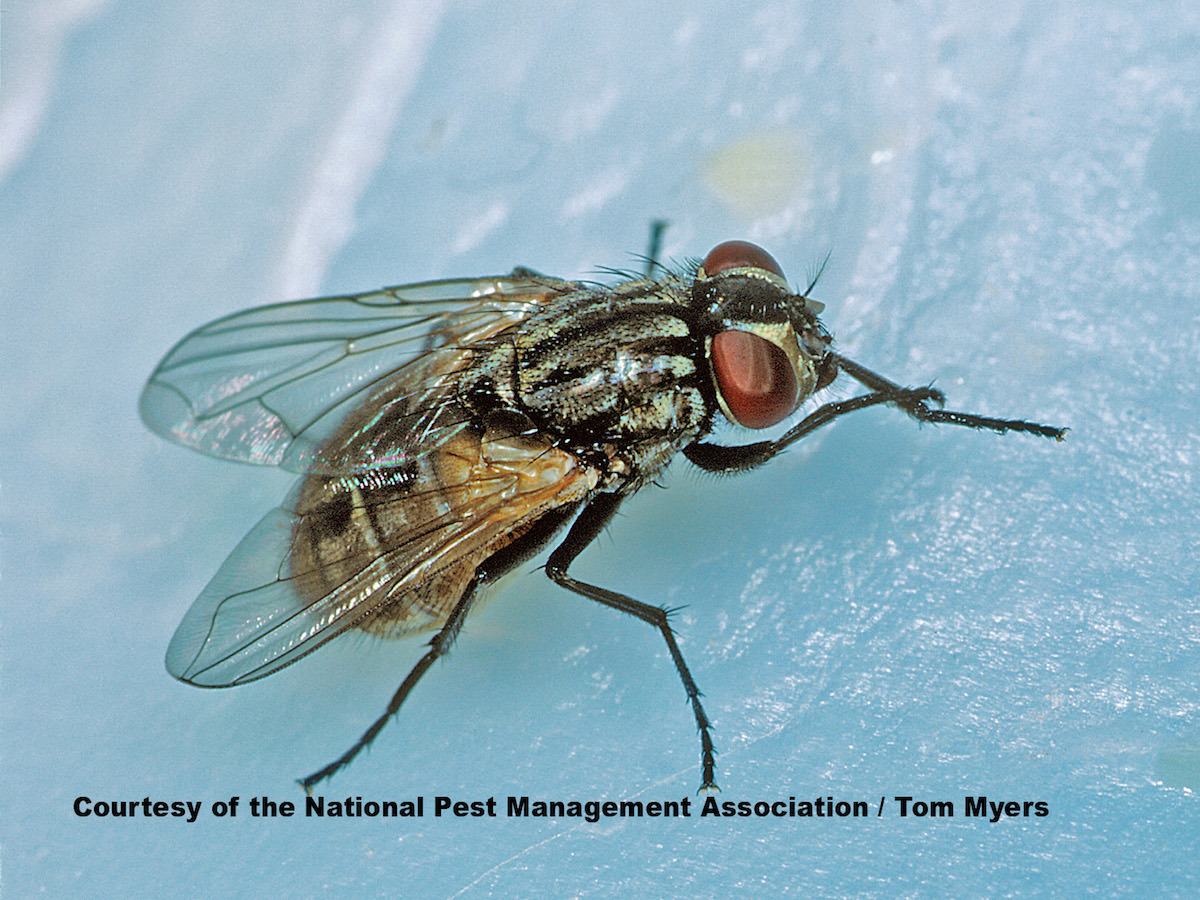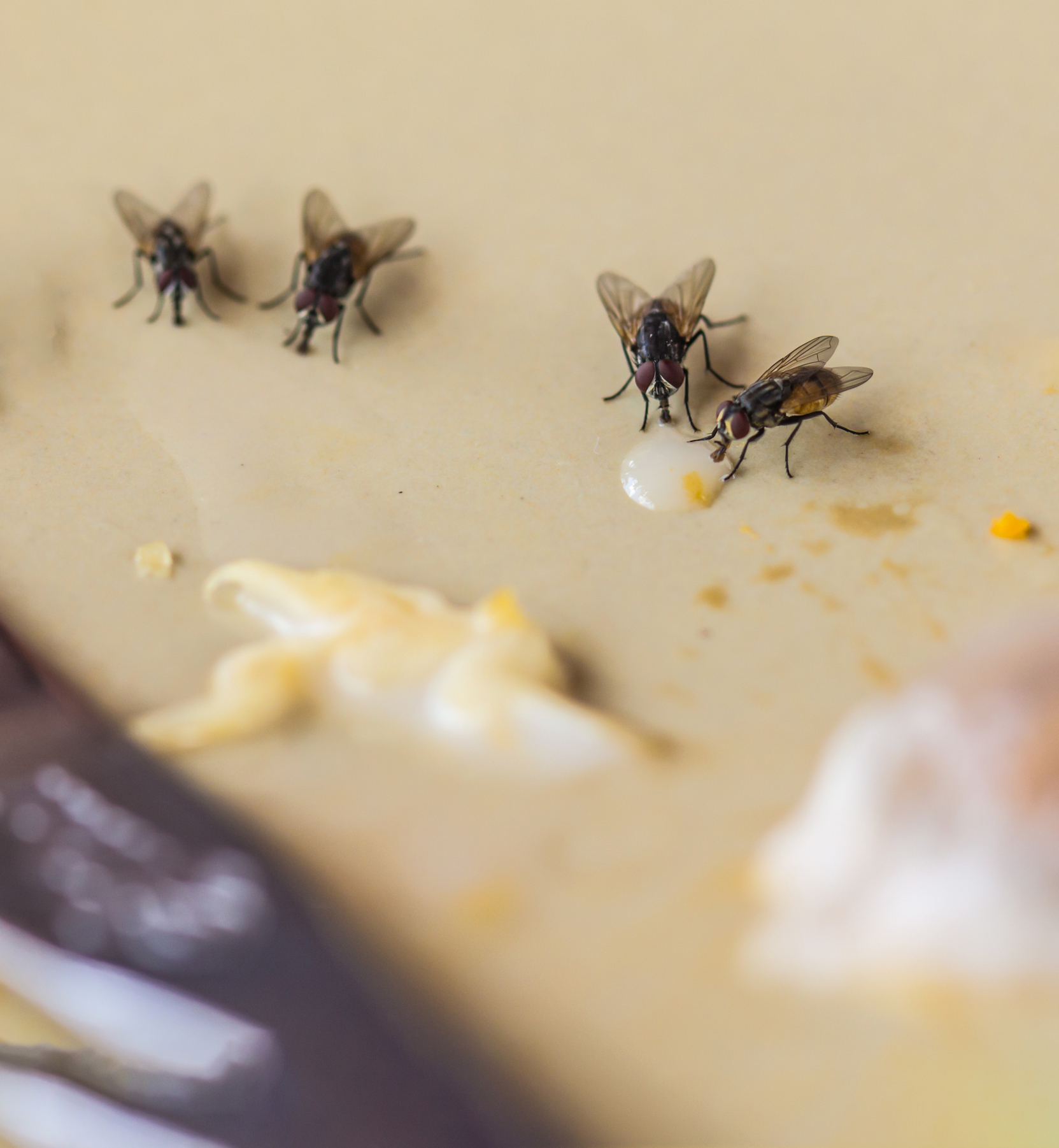House Flies Musca domestica

House Fly Identification
Color: Dark gray
Size: Adults are about 1/8-1/4” (4-7.5 mm) long
Legs: They have 6 legs
Antennae: Yes
Shape: Small, oval
Region: Found throughout U.S.
What is a House Fly?
The house fly is the most common fly found in and around homes. It has a worldwide distribution and is prominent in the United States. House flies are not only nuisance pests while buzzing around homes, but they are potential disease carriers. House flies have short lifespans, but they can quickly reproduce in large numbers, leading to large house fly populations if not identified and effectively controlled.
What Do House Flies Look Like?
House flies are usually gray in appearance and display four black stripes on their thorax. Adult house flies are about 1/8-1/4” (4 to 7.5 mm) long. They have slightly hairy bodies, a single pair of wings and compound red eyes, which contain thousands of individual lenses that allow them to have wider vision. Female house flies are usually larger than males. House flies do not have teeth or a stinger.
House fly eggs resemble small grains of rice. The eggs hatch into larvae, also known as maggots, which range in size from about ¼-3/8” (7-10 mm) long. Maggots are cream colored with a greasy appearance. When entering the pupal stage, maggots develop dark, hard outer shells, legs and wings, ultimately emerging as full-grown adult flies.
Like many other pests, the house fly experiences a four-phase life cycle. Depending on conditions, the developmental time of a house fly from egg to adult may require as little as six days. The life cycle begins when a fertilized female house fly finds a suitable location to lay her eggs, oftentimes on feces, carrion or garbage. She will reproduce about 5-6 times, laying batches of about 100 eggs during each round. Female house flies usually only mate once, but are capable of producing between 350-900 eggs in their lifetime. The eggs, which are white and about 1.2 mm in length, can hatch in 12-24 hours in warm weather. Pale-whitish larvae often referred to as maggots emerge from the eggs. About 3-9 mm long, these legless larvae feed at the egg-laying site for three to five days. At the conclusion of this period, larvae seek out a dark, dry and cool environment to pupate. Over the course of three to six days, the pupae develop legs and wings, and grow into fully-grown adult house flies. After two to three days, the adult female house flies are fully ready and able to reproduce, restarting the life cycle. Adult house flies typically live 15-25 days.
House flies are usually only active during the daytime when they will congregate indoors on floors, walls and ceilings. Outside, house flies opt for hanging around plants, fence wires, garbage cans and the ground. At night, house flies can usually be found resting 5 to 15 feet off the ground and close to sources of food. Positioning themselves in indoor corners and edges, they can survive cold winters by hibernating.
House flies tend to stay within 1-2 miles of where they were born, but they have been documented for migrating up to 20 miles in order to find food. Since house flies don’t have teeth, they can only feed on liquids. However, they use their sponging mouthparts to liquefy many solid foods through spitting or regurgitation. Their tongues are shaped like straws to suck up the food. House flies feed on a wide variety of substances such as human food, animal carcasses and garbage. They are particularly attracted to pet waste because of its potent odor.
House flies do not bite, but they are capable of transferring more than 100 different pathogens, including salmonellosis, typhoid and tuberculosis. House flies contaminate food surfaces by spreading disease organisms picked up on their legs and mouths when feeding on trash, feces and other decaying substances. Plus, they defecate constantly.

The most common sign of a house fly infestation is the presence of the flies, themselves. Larvae may also be seen crawling out of their breeding material as they pupate. Along with seeing house flies, people may hear them around the home. House flies produce a buzzing sounds which is a result of their two wings beating together.
House flies take advantage of structural issues, such as damaged weather stripping or torn screens, in order to enter a household. These pests are attracted to buildings by air currents and odors. Due to the fact that their preferred temperature is 83 degrees Fahrenheit (28 degrees Celsius), house flies are attracted to warm air currents coming from buildings on cooler days and vice versa on warmer days.
If you suspect a house fly infestation in your home, contact a licensed pest control professional to conduct an inspection, specifically looking for any places where house fly eggs may have been deposited. Since house flies enter from outside, internal breeding sites are not common. However, interior garbage rooms and compactors provide a suitable environment for house fly breeding sites and should be checked. If the breeding site is not thoroughly cleaned or removed, these pests will continue to be a problem.
Once the breeding site has been disposed of, eliminating the existing adult flies is the next step. A pest control professional will develop a house fly treatment plan based on the circumstances of the infestation, which may include the use of fly bait, applications or traps.
In order to prevent a house fly infestation from happening in the first place, vigilant sanitation is a must. Regularly removing trash and using well-sealed garbage receptacles can help to deter any house flies from residing around waste bins. Additionally, pet waste must be cleaned up immediately in order to prevent the development of any house fly breeding sites. Finally, fine mesh screens should be applied to doors and windows in order to prevent house fly entry into the home. If window screens are already present, make sure there are no visible rips or tears.
When you are ready to contact a pest control professional, you can find one with the helpful zip code search below.


